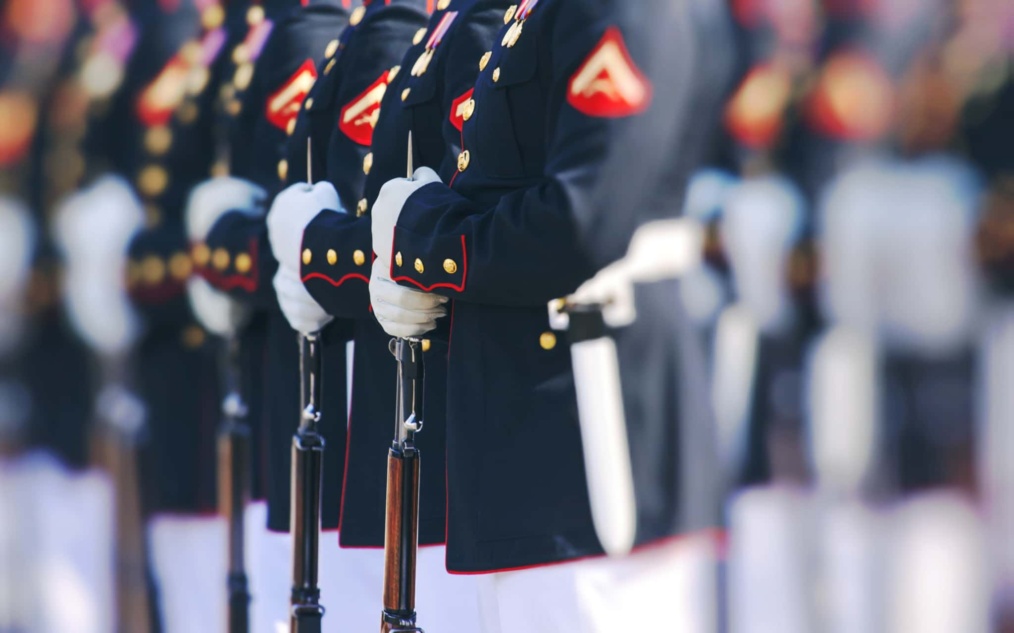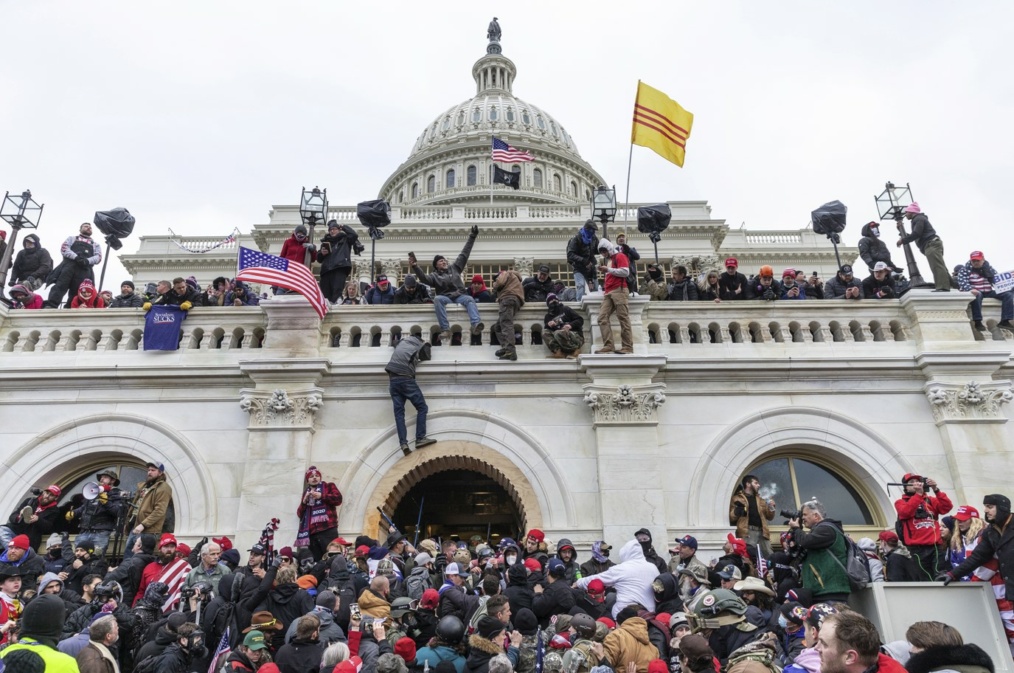On January 6, 2021, a violent mob of Trump supporters launched an attack on the United States Capitol. They tore through the security perimeter, overwhelming police lines and invading the building. As the rioters attempted to break down the makeshift barricades defending the House Chamber, armed guards drew their weapons and members of Congress removed their lapel pins so as not to be identified. For U.S. Representative Jason Crow, a Colorado Democrat trapped inside the chamber, the intentions of the rioters were clear, “they were going to try to kill members.”
One year after the January 6 attack, the identities of those involved are being revealed, exposing a leading role for individuals with ties to the U.S. military. Of the 727 defendants charged in the attack, at least 81 have a record of military service, including Ashli Babbitt, an Air Force veteran fatally shot attempting to breach Speaker Nancy Pelosi’s office suite. Over one quarter of these individuals were commissioned officers, and 44% had a history of deployment.
Of particular concern for security experts is that 37% were associated with violent extremist groups, including the Proud Boys and the Oath Keepers, making those rioters with military backgrounds over four times more likely to be part of such groups than rioters without. Indeed, this data reflects previous findings from the Justice Department’s Terrorism Research and Analysis Project, which suggest a significant over-representation of individuals with military backgrounds in right-wing extremist groups, including positions of leadership.
The prominence of these individuals in the attack highlights concerns of an upsurge in right-wing extremism within the U.S. military. Whilst officials attribute this growing extremism to broader social trends, security experts warn that the radicalization of service members, many of whom have undergone specialized military training, represents a critical threat. Indeed, according to Kristofer Goldsmith, former chief investigator at Vietnam Veterans of America, “we’re already in the early stages of an insurgency in the United States.”
Between 1990 to July 2021, at least 354 individuals with military ties committed criminal acts motivated by extremist aims, according to a research brief by the National Consortium for the Study of Terrorism and Responses to Terrorism. It was found that between 1990-2010 there was an average of six criminal cases per year, but in the last decade that figure has tripled to 21 cases per year.
Whilst most of these acts are perpetrated by veterans, the “vast majority of [whom] actually became extremist after they were in the military,” according to Mark Pitcavage, a specialist on far-right groups for the Anti-Defamation League, the Department of Defense has also reported extremist activity among active-duty troops, including around 100 substantiated cases in 2021 alone. Indeed, according to a poll by the Military Times, over one third of active-duty troops have witnessed displays of white nationalism or ideologically-motivated racism in the U.S. military.
History of Extremism in the U.S. Military
Right-wing extremism in the U.S. military is far from new, according to Cassie Miller, a research specialist for the Southern Poverty Law Center, “historically, this has been a problem for the military.” In the 1960s, Black soldiers in Vietnam filed reports of white soldiers flying Confederate flags and celebrating the death of civil rights leader Martin Luther King Jr. by parading in Ku Klux Klan-style robes.
In the 1970s, the K.K.K. was found to be operating openly at a U.S. Marine Corps base in California. In 1986, the Southern Poverty Law Center issued its first warning to the Pentagon concerning racially-motivated extremism in the U.S. military. In 1995, Army veteran Timothy McVeigh, an anti-government extremist detonated a truck bomb beneath a federal building in Oklahoma, killing 168 people in the deadliest domestic terrorist attack in U.S. history.
The January 6 attack, alongside a recent spate of foiled extremist plots, suggests a new surge in right-wing extremism within the U.S. military. These include an attempt by an Army private to orchestrate a murderous ambush on his own unit by passing secret information to a satanic neo-Nazi group; a plan to bomb a Black Lives Matter protest by three Nevada men with military backgrounds; and a failed ploy to kidnap the governor of Michigan involving two former Marines. “There is a crisis issue,” says Representative Jason Crow, a retired Army officer and member of the House Armed Services Committee, “the rise of extremism and white supremacy in the ranks.”
After January 6
Following the Capitol Hill riot, Secretary of Defense Lloyd Austin instituted a highly unusual military-wide “stand down” to address extremism within the ranks. Mr. Austin ordered that all military commands use this pause in operations to reinforce restrictions on extremist activity and to discuss troops’ views on the issue. After the stand down, a working group was established to support a Pentagon-led review of the prohibitions on extremist activity amongst service members.
“We don’t know the full breadth and depth of this,” said Department of Defense (D.O.D.) spokesman John Kirby at the time, describing the prevalence of extremism within the U.S. military. “It may be more than we’re comfortable feeling and admitting, and probably a lot less than the media attention surrounding it seems to suggest it could be. But where is it? It’s just not clear.”
Last month, following the conclusion of its review, the D.O.D. announced a set of updates to its guidelines on tackling extremism in the ranks. The new policies include strict prohibitions on social media activity. Under the new restrictions, “liking” or sharing extremist material will be considered advocacy and could result in disciplinary action. They also clarify behaviors considered active participation in extremist groups, such as rallying and fundraising.
Moreover, the updates involve enhanced screening of recruits. The military services all apply some degree of screening for extremism among their new entrants, including criminal background checks and the Marine Corps’ “moral qualification screening” forms. The guideline updates will further enhance these procedures. Further, efforts will be made to prepare retiring troops from being recruited by extremist groups.
Shortcomings in the Current Approach
Some experts warn that the guidelines are insufficient for tackling extremism among U.S. troops. The new D.O.D. rules do not prohibit membership of extremist organizations, such as the K.K.K. or the various right-wing militias seen at the Capitol Hill riot. Whilst the armed forces strongly discourage membership of extremist groups, this behavior is difficult to challenge in its protection under the First Amendment.
Concerns have also been raised regarding the enforcement of the new rules. The guidelines on prohibited social media activity do not include a list of banned organizations and have been described as “loosely defined” by a former chief prosecutor for the U.S. Air Force.
Moreover, it is unclear how the new rules will be enacted. “There’s no methodology in there,” said Kirby, announcing the new guidelines. Commanders are expected to be notified of concerns through “various streams of reporting.” Experts are concerned that the near total discretion of commanders to implement the new guidelines will further entrench the scattershot enforcement of counter-extremism procedures.
Further, whilst the D.O.D.’s review recommends the establishment of a dedicated central office for addressing extremism among troops, this proposal has not been implemented, and the Pentagon lacks a dedicated budget for counter-extremism work within the ranks.
“I really think the best option for their side of things would be to kind of create more of a centralized office that is staffed by a bunch of case managers … focusing on nonpunitive measures first,” said Andrew Mines, a research fellow at the Program on Extremism at George Washington University. “You can give commanders all the training you want, they’re still never going to be at the point where they have the same kind of competencies and expertise that folks with mental health background, with kind of generalist backgrounds in extremist organizations and extremist ideology”
Conclusions and Recommendations
In sum, the efforts of the D.O.D. in their updated guidelines do not go far enough to address increasing extremism in the armed forces. Whilst “the overwhelming majority of the men and women of the Department of Defense serve this country with honor and integrity,” said Mr. Austin, security experts are concerned by surging right-wing extremism among the ranks of the U.S. Armed Forces. “If leadership is not in touch with the people they’re leading, this kind of thing can happen,” stated Mr. Austin while discussing the January 6 attack before the Senate Armed Services Committee. “I don’t think this is anything you can just put a Band-Aid on and fix.”
The Pentagon also needs to expand support for retired troops. Veterans are key targets for extremist groups, and data suggests that they are particularly vulnerable to the recruitment efforts of these organizations. Indeed, most extremists with military backgrounds underwent radicalization after leaving the armed forces. Therefore, while the new guidelines include some provisions for retiring troops, more work needs to be done in this area, and the Department of Veterans Affair should introduce a dedicated counter-extremism program.
Finally, the D.O.D. must investigate the underlying social and psychological drivers of extremism in its ranks. Officials recognize that surging right-wing extremism among troops can be attributed to broader trends in Western society. Yet the updated approach does little to acknowledge or address these deeper grievances surrounding American democracy, and the various economic and cultural frustrations empowering extremist recruitment efforts. Indeed, according to Mines, if you “don’t focus on the primary prevention side, you’re always going to be playing whack-a-mole.”
Extremism in the ranks of the world’s most powerful military force is a serious security risk, both within the United States and beyond. Tackling this threat will require a more effortful approach than simply restricting social media activity or enhancing screening protocols.
The Pentagon should adopt a comprehensive strategy to address extremism within the armed forces. As social division in the United States continues to grow, with trust in institutions collapsing, and Americans increasingly drawn toward extremist narratives, it becomes ever more important that attitudes, beliefs, and ideologies discordant with American values do not go unchallenged in the armed forces. The task is huge, but it must be undertaken, and it will require far more than a simple Band-Aid.
Oliver Alexander Crisp, Counter-Terrorism Research Fellow


